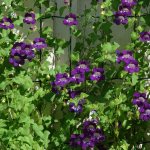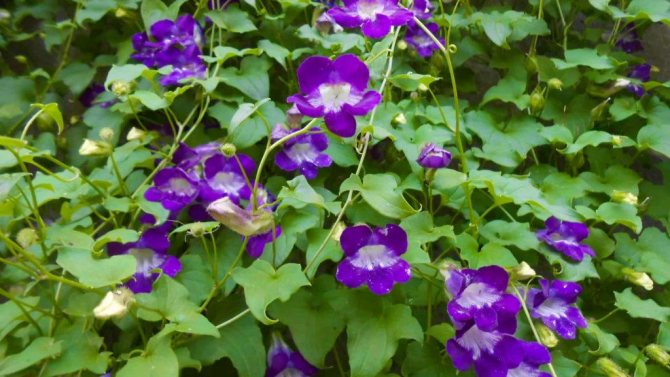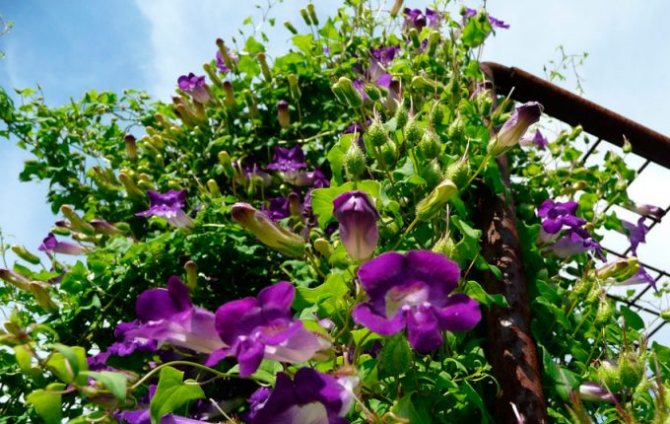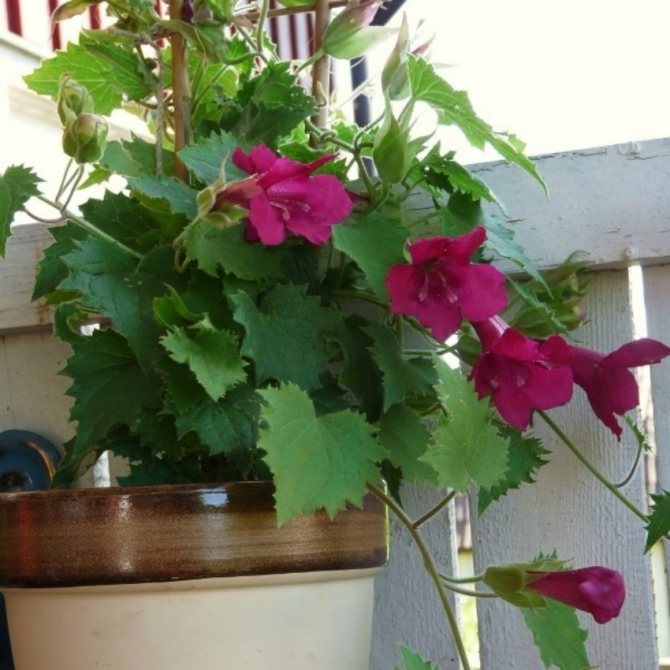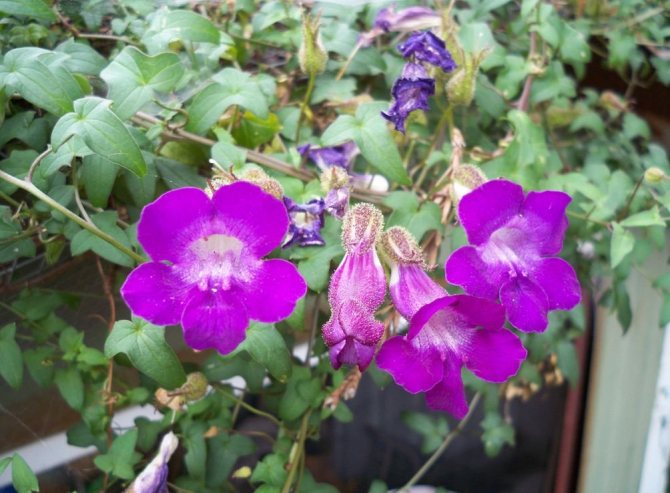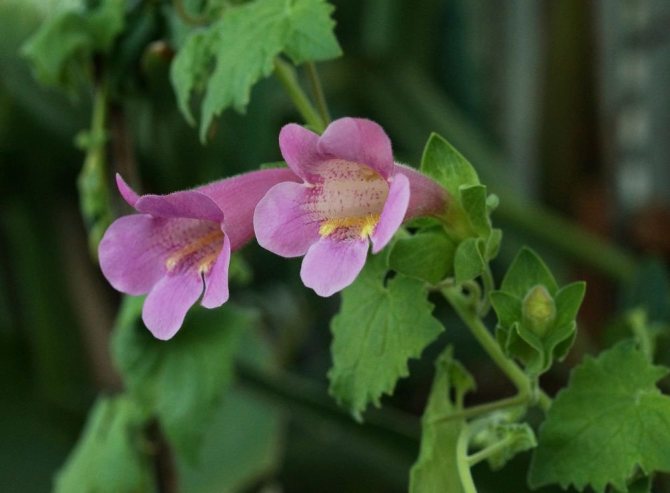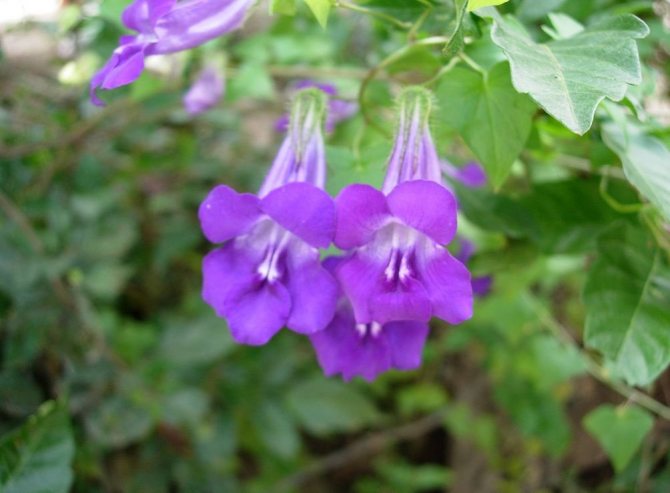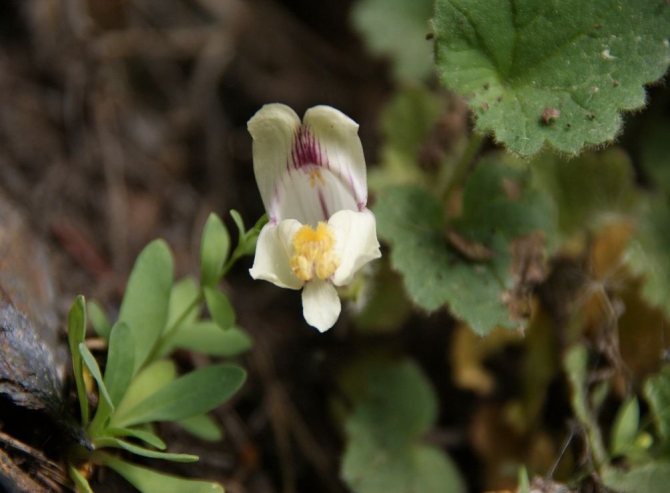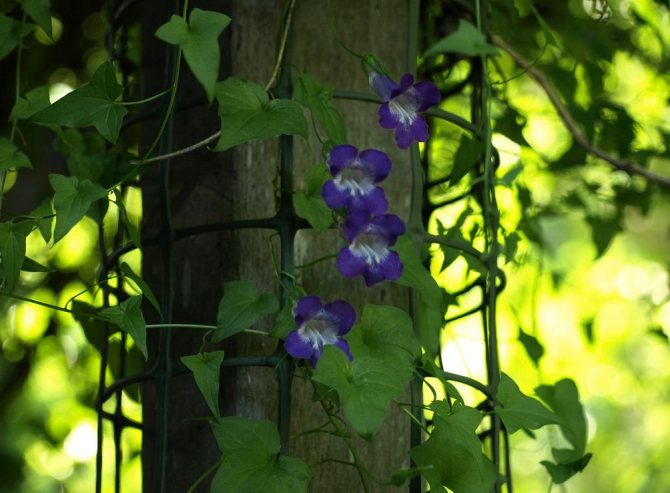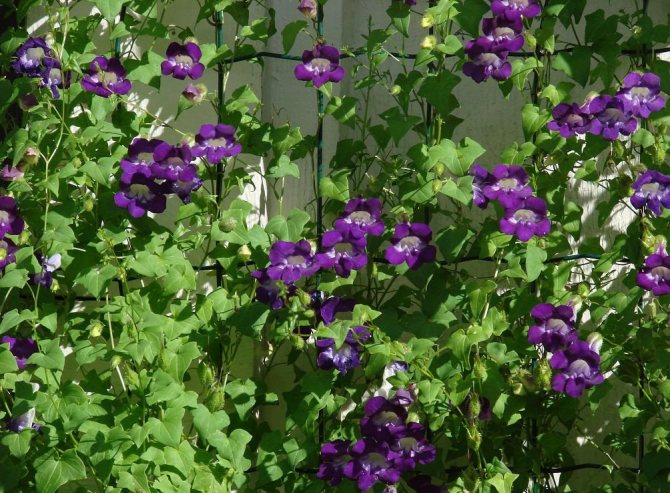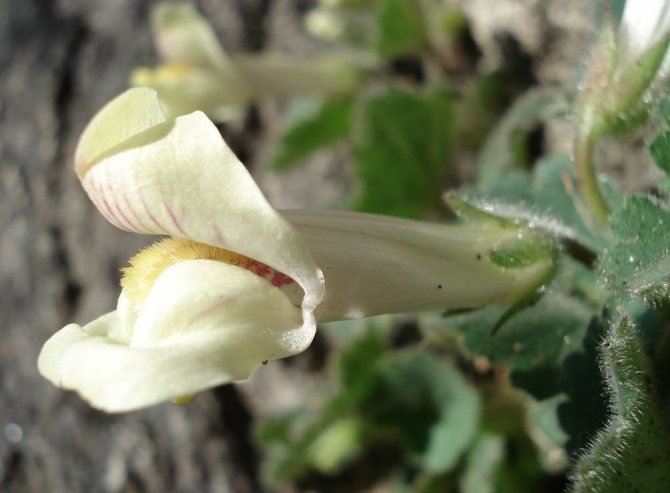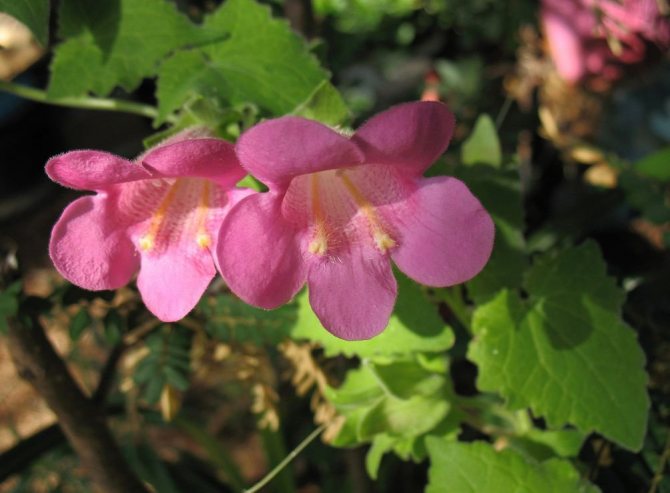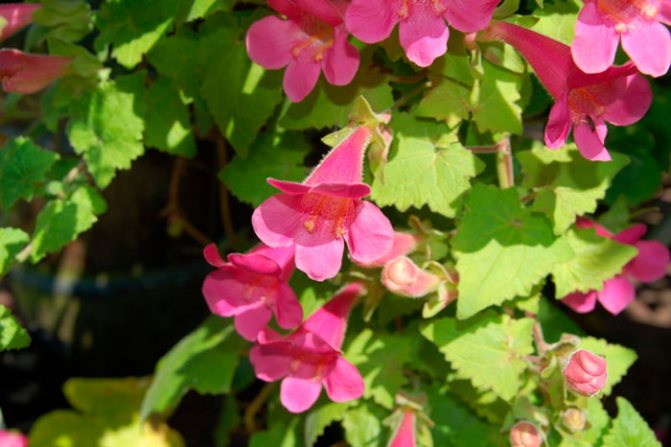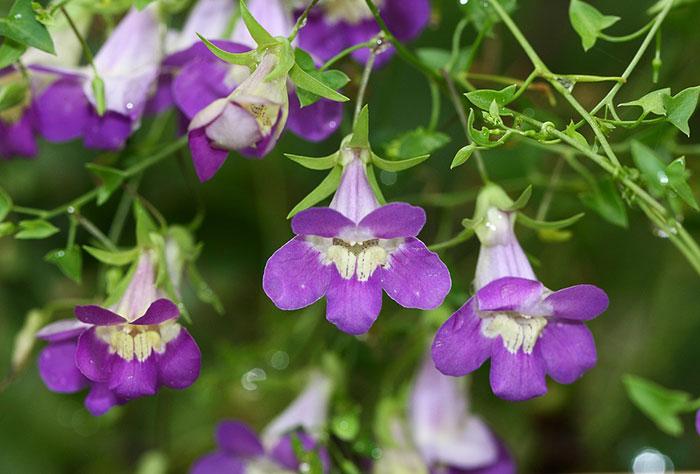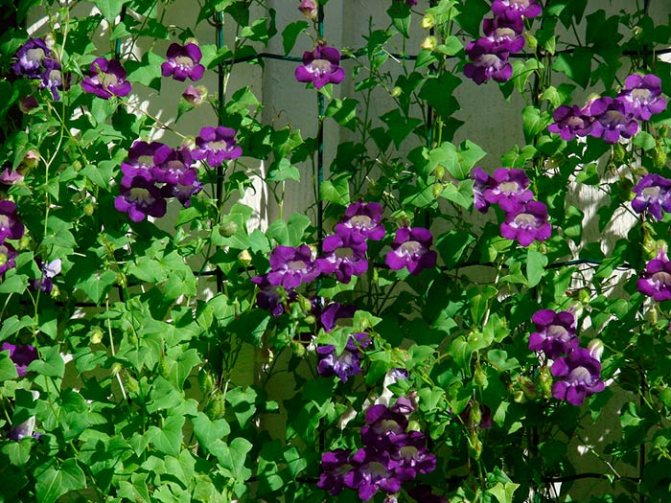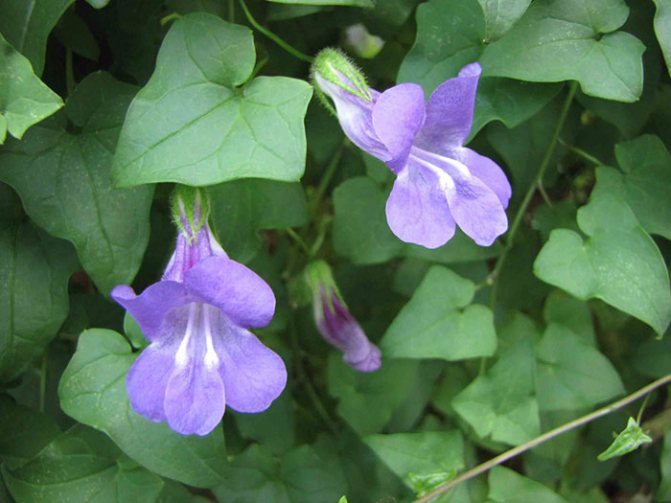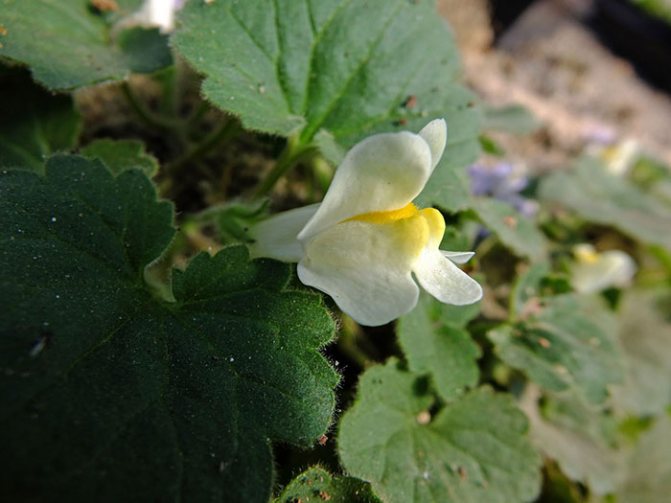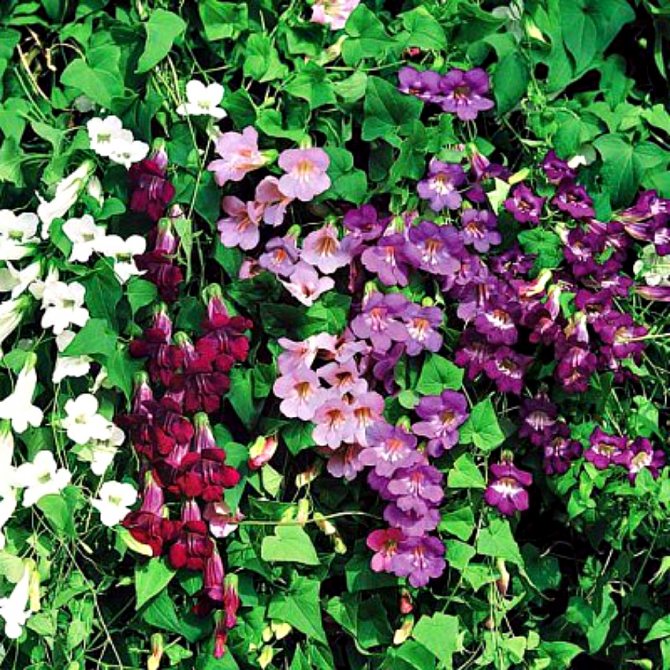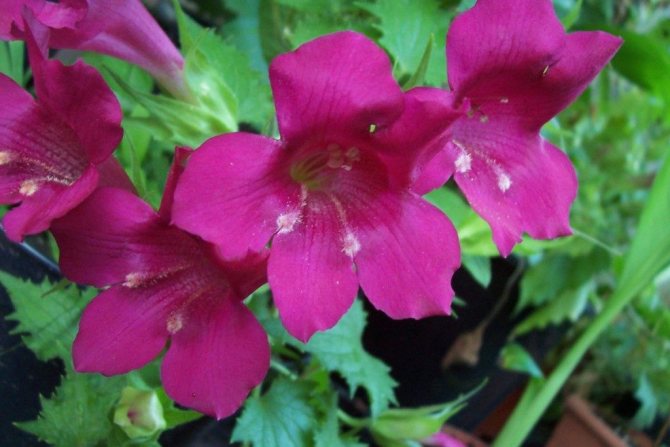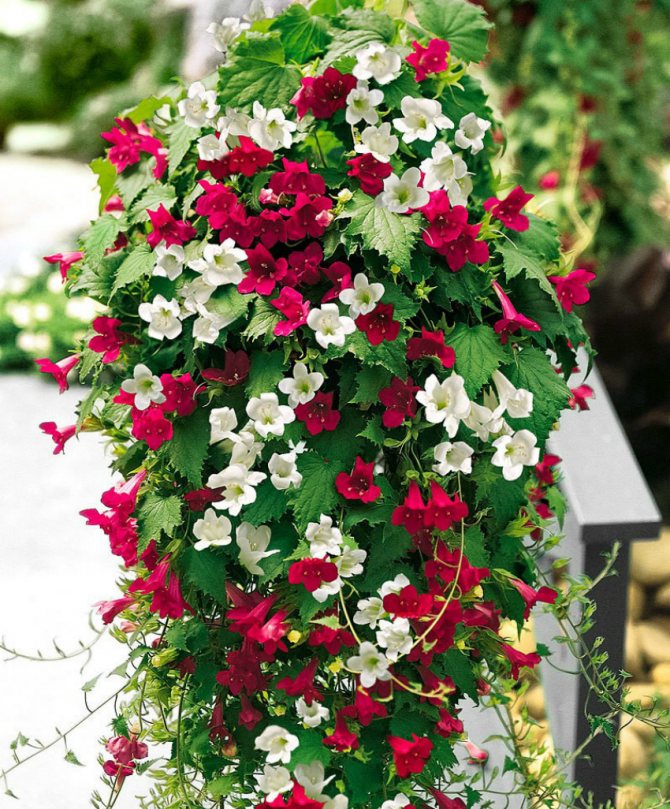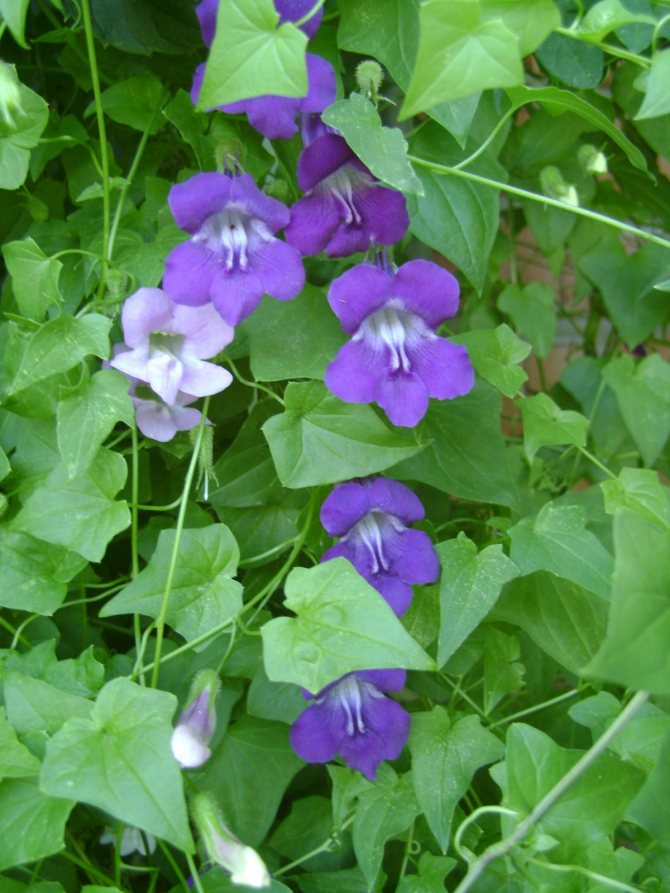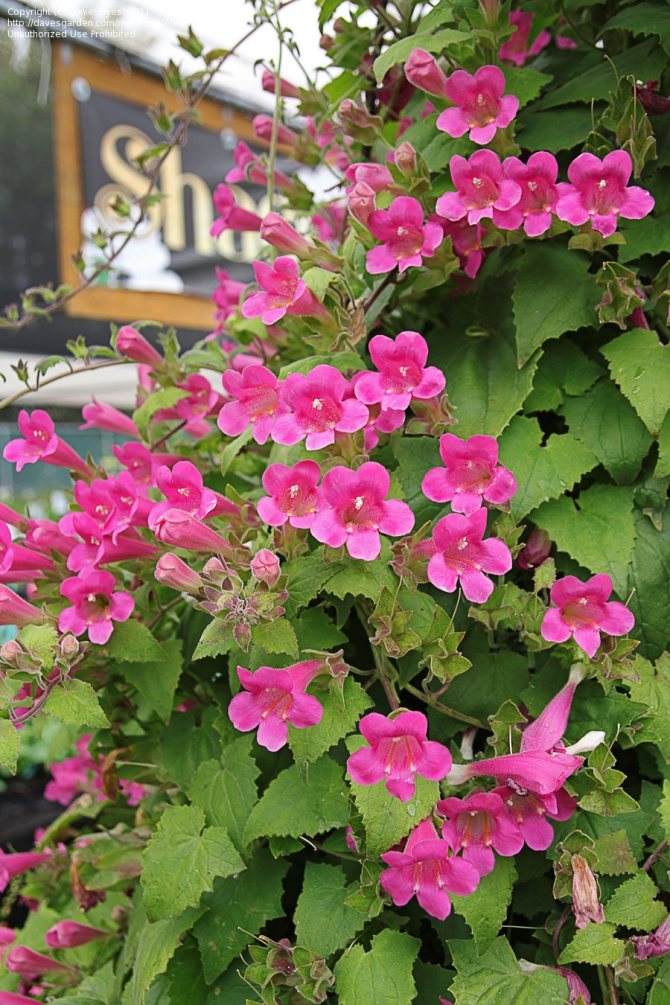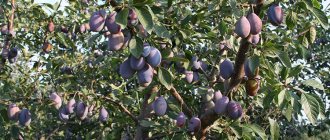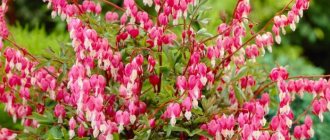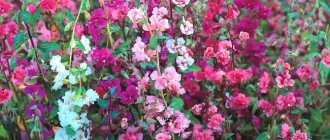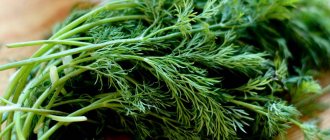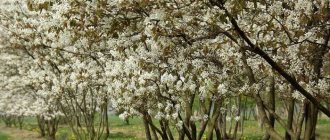Currently, vertical gardening is gaining momentum in landscape design and gardening. For connoisseurs of bright, pleasing to the eye flowers - a real find - a red-blooming beauty-liana, maurandia azarina.
Coming to us from Mexico and the central regions of the United States, she took an honorable place in the hearts of Russian gardeners. The secret of her popular eyes of flowers is a real find - the red-blooming beauty-liana, asarina maurandia. Brightness is bright, velvety, abundant flowers of various colors, dense foliage resembling ivy, as well as rapid growth and unpretentiousness.
This blooming vine is successfully decorated with gazebos, balconies, winter gardens, rocky slopes, terraces and vertical garden structures. Its bright flowers bloom in the first month of summer and last until the first frost. In a temperate climate, due to the fact that it does not tolerate frost well, asarina is considered an annual. But in its warm homeland, it is a perennial plant.
Plant characteristic
The plant has highly branching shoots. It is worth noting that asarina grows at an incredible speed and the small thin sprouts that appear after pecking seeds should not frighten, asarina can surprise. The liana blooms all summer and even the first frosts do not interfere with it.
The shoots are woven along the support, the leaf plates are medium-sized, bright green, can be velvety or smooth, the edges are jagged or straight, depending on the variety. Flowers are tubular, solitary, growing along the entire length of the shoot. The color of flowers is widespread pink, lilac, red and purple, less often white or yellow. Bicolor asarin is even rarer. At the end of flowering, a fruit is formed with seeds in the form of a small box.
Disputes about the belonging of the plant to the plantain and norichnik family are still ongoing. Given the great decorativeness and beauty of the plant, the simplicity and unpretentiousness in growing, you should not go into these nuances, but simply plant and enjoy azarina on your site.
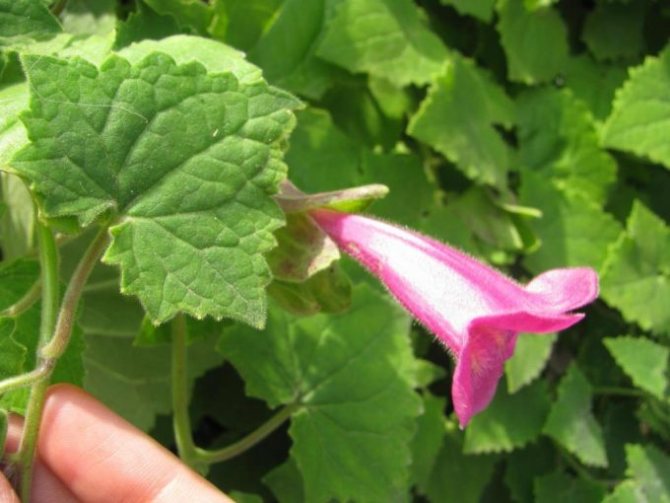
Features of care, frequency of watering
Azarina does not like the cold, therefore, they are planted in open ground when the heat comes. For maurandia to bloom profusely, choose a flower bed on the south or east side for planting. Before planting, loosen the soil, add peat (if the soil is dense), lay drainage at the bottom of the hole. The first days after planting, it is necessary to cover the seedlings so that they get used to direct sunlight. Experienced gardeners know that any seedlings must be "hardened". Plant care in the open field is not difficult:
- loosen the soil;
- remove weeds;
- fertilize.
Attention! For bushiness and the formation of a larger number of shoots, and the investigator and more abundant flowering, it is necessary to pinch the tops of the shoots.
Watering is carried out depending on natural conditions. Until the roots are firm, you need to water often and little by little. With prolonged drought, watering is carried out twice a day: in the morning and in the evening. The water should be warm and filtered.
Azarin varieties
Since the plant is quite popular among flower growers, and there are a lot of species, we will consider the most popular varieties, which are more often found in Russian gardens.
Azarina climbing
The most popular type, during one season the vines reach three meters, the leaves resemble ivy in shape and size, the flowers can be pink, white, blue, purple and red, depending on the variety.


Reddish
Lianas grow on average 2.5 meters, the stem of this species is lignified. In this case, the stems become brown and acquire a dense bark. The flowers of this asarin are only pink, the edges are brighter than the tubular part. The bud can be up to seven centimeters long.
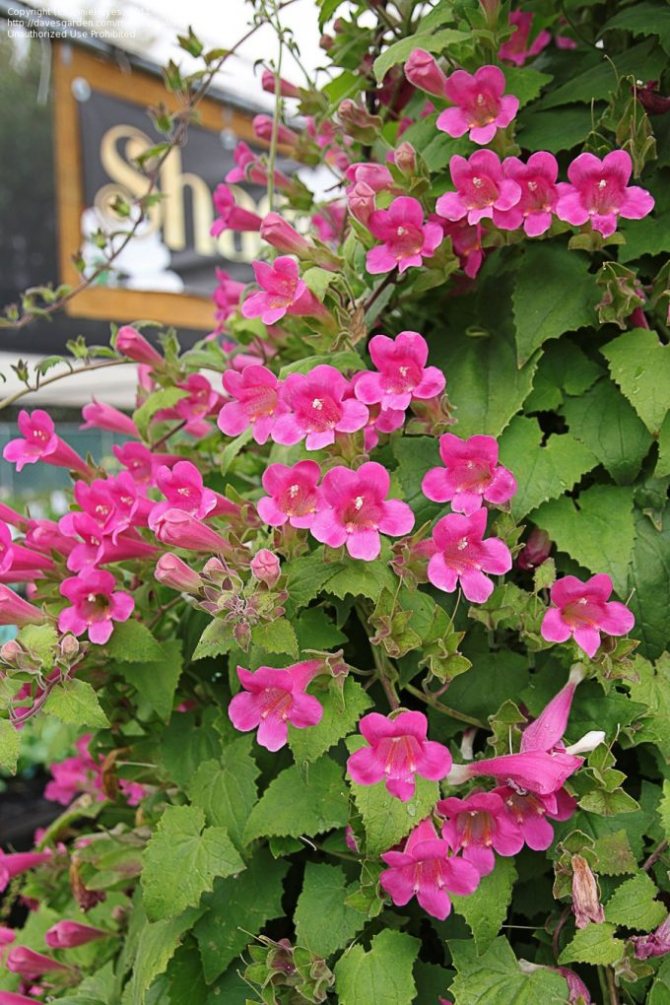

Azarin Barclay
The owner of the largest flowers, up to seven centimeters in diameter. The foliage is naked, heart-shaped, the greenery grows incredibly quickly. Flowers, with a white center, may differ in purple, scarlet or purple edges. The growth rate of this vine is incredible, it is able to grow a vine up to 3.5 meters in length within two months. More than other species are suitable for indoor cultivation.
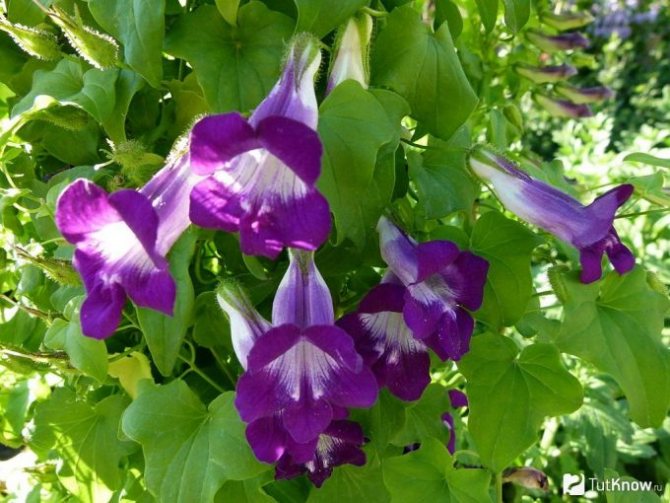

Azarina antirrino-flowered
Shoots of this species are capable of branching up to 1.5 meters, emerald foliage covers the stems densely, and flowers are collected in racemose groups. The colors can be blue, scarlet, pink and purple.
Popular: We create hanging gardens in an apartment with indoor vines
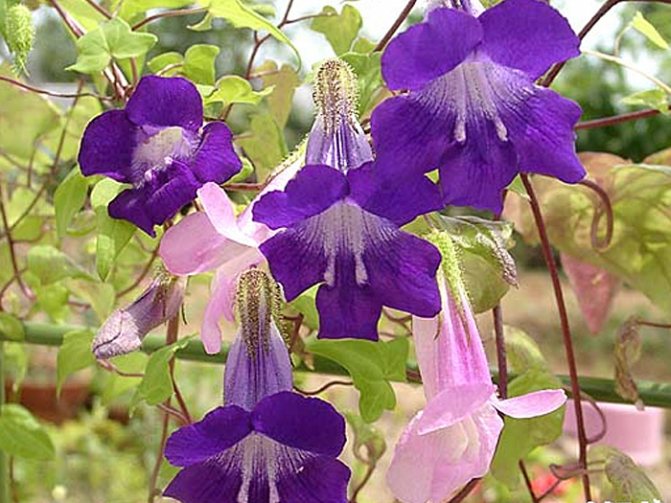

Azarina prostrate
This variety is more suitable for growing on slides, rockeries and pots. The leaves are dark green, the flowers are yellow. It is more often grown as an annual due to its inability to withstand frost.
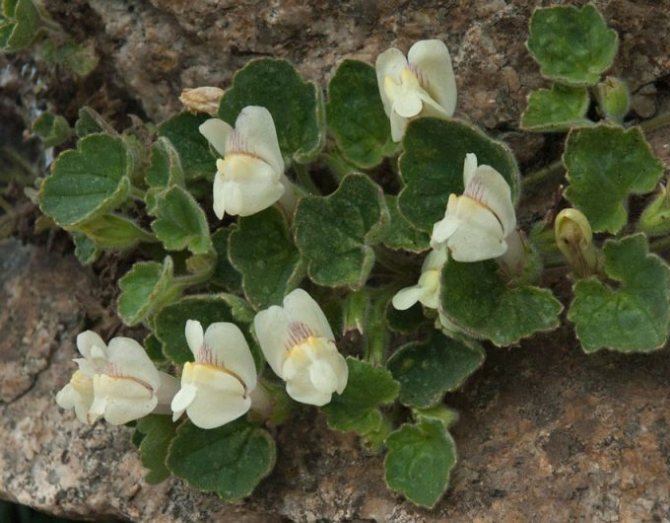

Purpusa
The shortest type of asarin, shoots reach 40 centimeters in length, leaves and flowers are large, for this species, and grow up to five centimeters. The foliage is cordate, the inflorescences are fiery red or purple, the pharynx is striped, slightly lighter than the main shade.


Azarina Wislicena
The main advantage is the large flowers of blue or lilac color, there are also scarlet shades. The length of the shoots is up to three meters, the foliage is abundant in bright green color.


Description
Climbing azarina (lat. Asarina) is a genus that includes mainly climbing vines. Belongs to the Norichnikov family (in Latin Scrophulariaceae). In the literature, it is often called maurandia. Its branched stem reaches 4 m in length, in its natural environment it can reach 7 m. The plant can creep or climb. Shoots are covered with long-stemmed leaves, shaped like an arrowhead or more rounded, heart-shaped with smooth edges. Most often with a velvety surface. Asarin does not have antennae, but clings with its leaves to a vertical support. Therefore, sometimes it is necessary to control its growth in order to achieve the best aesthetic effect.
The single-disposed flowers, in the shape of a calyx, consist of 5 pointed sepals covered with villi. Visually, they resemble a tube, expanded in the middle part and divided to the apex into five rounded, unequal petals, and its corolla consists of two curved lips (three lobes at the bottom, two at the top). Asarin flowers have been compared to a gramophone and are sometimes called “snapdragons”. The flowering period usually occurs from mid June to mid September.
The fruit of the plant is a spherical box of irregular shape. When ripe, it has two holes at the top. Seeds are formed in large quantities and are a brown oval with a rough surface and bulges.
Reproduction
Reproduction usually takes place by seeds, which are formed after flowering. It is important to have time to collect them, otherwise the boxes will burst and the seeds will scatter. Asarin cuttings also take root well, but this method of propagation is practically not used in gardening.
In the wild, asarina is a perennial, but the temperature of Russian latitudes does not allow the plant to carry out the process of rejuvenation and reproduction using the branches of the root system, it simply freezes.


Sowing dates
Seeds are sown in the ground in mid-February - early March. If you do this later, you may not see the active flowering of the vines. After 2.5 months, the plant reaches the age when it can be planted in the ground. It is important to take into account the appearance of frost and take out the asarina outside, only after the danger has passed.
The soil
The soil for the creeper will require loose, fertile, you can use garden soil with the addition of humus and sand. The soil must be calcined and moistened before planting. You can disinfect the soil using a microwave, turning it on at maximum power for ten minutes or putting it in a water bath for half an hour. After that, you can additionally spill with a solution of potassium permanganate. After a day, you can sow seeds.
Sowing process
Before planting, it is not necessary to process the seeds, immediately after preparing the soil, they are distributed on the surface, slightly deepened, sprinkled with sand for 5 mm, then watered and the container is covered with a film. Seedlings will appear in 20 days, after which it is necessary to remove the shelter, but not immediately. The film should be removed daily for 2-3 hours to ventilate the soil, and after 10 days, remove it completely.
If a month has passed and no shoots have appeared, then you need to remove the seedlings in the refrigerator for about a month. This procedure will wake up the seeds, and they will hatch, flowering will be postponed for 30 days, but the plant will still bloom and delight with its dense greenery. If the seeds are old, then they may not wake up, and therefore only fresh materials for growing should be used.


Picking
After the appearance of two real leaves, the plants must be transplanted into separate peat containers, removed to a cool room until they are planted in open ground. The procedure is carried out very carefully so as not to damage the plants, it is better to use a thin instrument, you should first moisten the soil well. The temperature in the room should not be higher than 17 C. During this period, little watering of asarin should be done.
Popular: Evergreen hypocyrtes with scarlet citrus on the windowsill
Peat cups are used for picking, because the plant does not tolerate damage to the roots, and such containers will not disturb the asarin roots once again.
Landing in the ground
Before planting, the seedlings must be hardened. To do this, within a week, a box with small plants is taken out into the street, starting with a stay for an hour and increasing daily to a day. For Azarina, you should choose an open area, preferably without strong winds. The plant will need support if it is a species with long vines. To prepare the earth you will need:
- peat;
- coarse sand;
- sod soil;
- sheet soil;
- humus foliage.
Saplings are planted at a distance of up to half a meter, it is desirable to give them more space. Too thickened plantings will bloom worse and begin to wither. After planting, mulching the soil will have a good effect; peat or grass is best for this.


Rooting cuttings
Most often, cuttings appear when an introduced plant stretches and exposes its stems for the winter. They are pruned to create a new strong plant, and the branches removed are used as cuttings. For their rooting, a soil consisting of sand and peat is suitable, the twigs are sunk into the ground, the roots will appear quickly, and after 20 days you will get strong plants that do not require additional maintenance.
Fertilizers
For more extensive greenery and abundant flowering of asarin, additional feeding is necessary. Fertilizers are applied weekly, organic and mineral fertilizers alternate. The first fertilizer is applied 15 days after the pick. For this, any fertilizer for flowering plants is suitable, it should be fed twice a month, until the planting in open ground takes place.
During the growing season, nitrogen-containing fertilizers should be used, and when forming buds and flowering, it is better to use phosphorus fertilizers. Of organic fertilizers, asarin reacts best to a solution of chicken manure.
How to propagate and fertilize Azarin climbing
Asarin propagates in 2 ways: seeds and cuttings. The first method is used for growing indoors or for planting directly into open soil.If they are grown at home, then the seeds should be sown in April, and if they are planted directly in the ground, then in winter or spring.
To prepare the soil for planting, you will need:
1.soddy land; 2. humus; 3. sand; 4. peat; 5. leafy ground.
Before planting the seeds, they must be placed in a potassium permanganate solution. The earth itself must be moistened and seeds must be poured into it, but do not sprinkle the earth on top. Then everything needs to be covered with foil and put on the windowsill.
Do not forget to open the film every day to ventilate. After about 1.5-2 weeks, the first shoots will begin. To make the seeds germinate faster, put the container first in a cold place for a while, and then in a warm, sunny place.
It is this method that will help speed up the germination of asarin seeds. It is necessary to transplant seedlings into pots or pots after they are fully strengthened
To propagate maurandia by cuttings, do not get rid of them after pruning. Place them in a container of water and after a while they will release roots. Then you can transplant them into pots.
You can fertilize for the first time after 2 weeks. Use for this example "Ideal". Then, also after 2 weeks, add Agricola or another identical product.
Nitrogen fertilizers are added if the maurandia looks pale, with small leaves. But potash and phosphorus products need to be applied if the leaves are bright enough and the shoots do not want to grow.
Plant care
If the vine has grown to eight centimeters, then it's time to start pinching the plant, then it will be more bushy and lush. For small asarin, it is better not to put supports before planting in the ground, otherwise it will be impossible to remove the plant from them afterwards.
Regular watering of the asarin and the formation of the crown is all that this vine needs. When growing, the stems need to be guided in the right direction, tied up. The ampel version will turn out to be more beautiful if you first let the shoots upward along the support, and when they reach a length of 60 centimeters, remove and straighten the vines. It is important that the pot for the ampelous version is at least 20 centimeters deep.
Popular: Landscaping garden design with perennial vine Basella
Asarin is not often watered, the plant tolerates small droughts well, and abundant watering can lead to root rot. Drying of the soil should be six centimeters deep, it will be useful to spray the entire crown, but you should not do this at lunchtime under the scorching rays of the sun, the best time will be early morning or evening. In extreme heat, it is possible to irrigate twice a day; for this, the condition of the soil should be constantly monitored.
The plant can overwinter only in the southern regions of Russia, and therefore for the winter the plant is brought into the room in flowerpots. The recommended temperature is more than +10 C.
Photo
And speaking of Narilatha photos, there are not many images of this flower on the Internet.
If you search through all the resources, you can find no more than 10 photos of this rare plant.
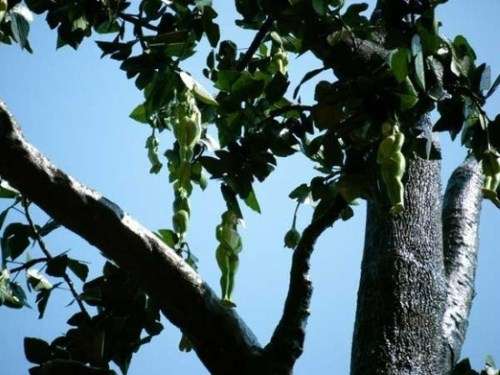

Some say the reason Narilatha photos are so rare is because they bloom once every 20 years. It is quite possible, especially since there is a video with this flower. Actually, there should be a lot more photos.
Diseases and pests
The most common disease of a vine is a black leg, it appears from an excess of moisture, can infect asarin and other fungal diseases. For prevention, treatment is carried out with diluted manganese or copper sulfate. In this case, healthy plants must be transplanted from the infected.
Aphids love to feast on the juicy greens of the creeper, a decoction of tansy with onion peel can be saved from it, chemical preparations can be used. Processing will have to be carried out several times, but not less than two.
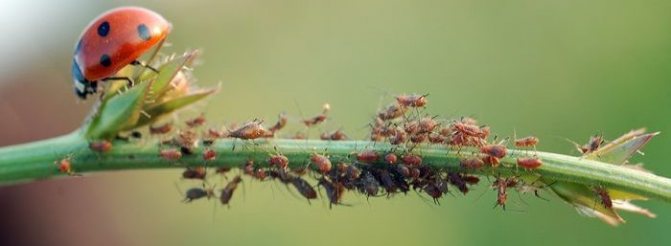

Azarina in design
Liana is a rather unpretentious plant, and it is also very decorative. Depending on the species, it is grown as a ground cover, ampelous or vertical. Looks great on balconies and loggias. Decorates gazebos and slides.
The most common place for growing asarin is fences, arches, barn walls. There are processes on the leaves of the plant, with the help of which the vine clings to the support. They are small, so the mesh diameter must be small for the plant to be comfortable. The plant grows quickly and gives a lot of shade, therefore it is irreplaceable for a gazebo.
Azarina is an outdoor plant, and therefore it feels much better in the sun than indoors. Despite this, growing in a room is also possible. Leaves and flowers will be slightly smaller, flowering is not as abundant and prolonged as in the open air.
Growing asarin does not require special knowledge and skills. Liana calmly refers to the heat, drying out of the soil, but prolonged inattention of the gardener can destroy the plant. It is important to admire this beauty as often as possible and control the condition of flowers and leaves. There will be practically no problems with pests. Chemicals, if necessary, can easily cope with such a problem.
Now read:
- Exquisite junkus (sitnik) spiral in the interior
- Choosing cucumbers for open ground according to your preferences
- Decoration and spicy pepper dish on the windowsill
- Confidentiality
Leading Researcher of the Laboratory of Vegetable and Berry Crops, Yakutsk Research Institute of Agriculture, Siberian Branch of the Russian Academy of Agricultural Sciences, Republic of Sakha (Yakutia).
Planting and care in the open field
When planting asarin, the distance between the bushes in a meter must be observed This is necessary for good development and further flowering of plants. Azarina will not bring a lot of trouble with it, but for productive growth and flowering, the bushes need to be looked after properly. One of the main requirements is soil loosening and moisture.
Remember! Watering should be moderate, but waterlogging and drying out of the soil should not be allowed.
It is worth remembering the following procedures:
- garter as the vines grow;
- regular root feeding;
- preventive work to combat pests and diseases;
- mulching the soil with peat.
In the first case, a garter is required for the plant that cannot catch on to the support. When the maurandia was planted next to the gazebo, it will easily surround its area on its own.
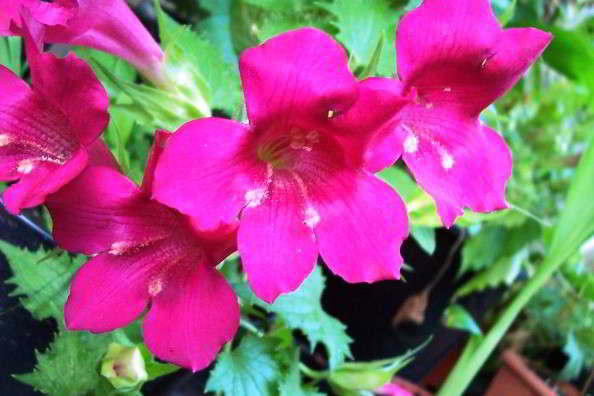

The advantage of asarin is that it is mostly disease resistant, so even a novice gardener will just take care of it. However, if not properly cared for, asarin can suffer from blackleg. This is a fungal disease that appears on young and weakened specimens. It manifests itself by means of blackening the root collar, which often leads to the death of seedlings. The cause of the onset of the disease is as follows:
- dense planting;
- excessive watering;
- too early sowing;
- keeping on a cold windowsill;
- poor ventilation of the room;
- sudden changes in temperature and humidity.
Know! Blackleg practically does not attack specimens grown in peat tablets, since they are sterilized and treated with fungicides before being sold.
But if the planting is carried out, nevertheless, in the prepared substrate, then it must first be disinfected by steaming or with a solution of manganese potassium. When young plants are affected, diseased specimens are removed, and the rest are treated with chemicals. In adults, all damaged areas should be removed, and the remains should also be treated with chemicals. Like most horticultural crops, it can be attacked by aphid or spider mite colonies.
The following folk remedies will help in the fight against aphids: regular shower, infusion of marigolds, infusion of dissected hogweed, infusion of white mustard powder, from ordinary dope, tomato tops, infusion of tobacco, decoction of garlic or onion, solution of wood ash, from alcohol and soap solution, infusion bitter pepper, diluted citrus juice.
Aphids breathe through the skin, so it does not tolerate strong odors, so the following remedies will also help in the fight: cigarette smoke, pelargonium decoction, kerosene, flea drops, non-chemical preparations containing oil. It is worth remembering about the natural enemies of aphids - the ladybug and its larvae.
Know! You can attract it to the site by planting fragrant plants, for example, dill or angelica.
The appearance of a spider mite can be detrimental to vines. As a prophylaxis against pests, regular watering and spraying of leaves and inflorescences is used. This is due to the intolerance of high humidity mites. You can get rid of parasites using the same folk remedies that are used against aphids. You can also use decoctions from:
- cyclamen;
- dandelion roots;
- persian chamomile.
To safely get rid of a harmful insect, you can use natural enemies - phytoseiulus and amblyseius. These predatory insects feed on eggs and the mites themselves. You can buy them in specialized stores or on the Internet.
Of course, chemicals that are sold in any gardening store will help from both pests. Such substances are used several times, with a difference of about a week, since they do not affect insect eggs. The main thing when using them is to observe the dosage.

